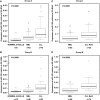Prognostic value of miR-155 in individuals with monoclonal B-cell lymphocytosis and patients with B chronic lymphocytic leukemia
- PMID: 23821659
- PMCID: PMC3779381
- DOI: 10.1182/blood-2013-01-478222
Prognostic value of miR-155 in individuals with monoclonal B-cell lymphocytosis and patients with B chronic lymphocytic leukemia
Abstract
Noncoding RNAs play a pivotal role in the pathogenesis of chronic lymphocytic leukemia (CLL). We hypothesized that microRNAs (miRs) are involved in the transition from monoclonal B-cell lymphocytosis (MBL) to CLL and tested miR-15a/16-1 cluster, miR-21, and miR-155 expression in purified B cells of normal individuals, individuals with MBL, and patients with CLL. When we analyzed 224 samples from 2 independent training and validation cohorts, we found that miR-155 was overexpressed in B cells from individuals with MBL, and even more so in B cells from patients with CLL, when compared with B cells from normal individuals. Furthermore, we were able to identify miR-155 in circulating microvesicles from both individuals with MBL and patients with CLL. Next, to examine the prognostic role of miR-155, we measured its expression level in plasma samples collected before treatment initiation in 228 patients with CLL. We found significantly higher miR-155 expression levels in patients who failed to achieve a complete response compared with those who experienced complete response. Our findings support the use of cellular and plasma levels of miR-155 as biomarkers for the risk of progression in individuals with MBL, as well as to identify patients with CLL who may not respond well to therapy.
Figures




Comment in
-
Microbiomarkers with big impact in CLL.Blood. 2013 Sep 12;122(11):1843-4. doi: 10.1182/blood-2013-08-514117. Blood. 2013. PMID: 24030253 No abstract available.
References
-
- Ambros V. microRNAs: tiny regulators with great potential. Cell. 2001;107(7):823–826. - PubMed
-
- Bartel DP. MicroRNAs: genomics, biogenesis, mechanism, and function. Cell. 2004;116(2):281–297. - PubMed
-
- Zenz T, Häbe S, Denzel T, et al. Detailed analysis of p53 pathway defects in fludarabine-refractory chronic lymphocytic leukemia (CLL): dissecting the contribution of 17p deletion, TP53 mutation, p53-p21 dysfunction, and miR34a in a prospective clinical trial. Blood. 2009;114(13):2589–2597. - PubMed
Publication types
MeSH terms
Substances
Grants and funding
LinkOut - more resources
Full Text Sources
Other Literature Sources
Miscellaneous

